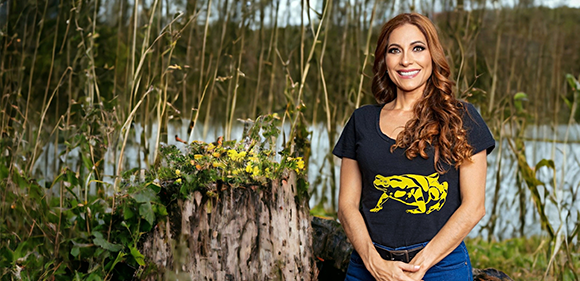We are delighted to announce a significant milestone for the Amphibian Survival Alliance (ASA) as we embark on a new chapter with the appointment of Dr. Gina Della Togna as our new Executive Director.
Gina’s appointment marks a pivotal moment in the evolution of ASA, symbolizing a blend of ambition and passion that mirrors the mission of ASA. With her wealth of experience, Gina is prepared to guide our initiatives, injecting fresh energy and momentum into the partnership with pioneering strategies and impactful projects.
Her leadership is characterized by diplomacy and empathy, essential qualities for managing our Global Council and ASA’s diverse global partnership. Gina possesses a profound understanding of the multifaceted cultures, perspectives, and global challenges integral to ASA’s work. She is dedicated to addressing these with respect and understanding.
Working together with ASA’s secretariat, Gina is committed to elevating the visibility of amphibian conservation and highlighting the far-reaching impacts of our collaborative efforts. She will also be actively exploring and cultivating new sources of support critical to advancing conservation within this community.
Many of you may already be familiar with Gina’s work and substantial contributions to amphibian conservation. Her dedication and deep-seated passion for amphibians are evident in the profound impact she has made already throughout her career.
We sat down with Gina and asked her a few questions about her background and passion for amphibian conservation. When asked about her motivation and experience in this field, Gina said “Well, I would describe myself as a very passionate, optimistic, problem-solving and strong-willed person, with a profound need, or should I say call, to make a difference in and leave a legacy for amphibian conservation. As a Molecular and Cell Biologist and a Reproductive Physiologist, I have been working for more than a decade now to develop and implement Assisted Reproductive Technologies for endangered amphibian species.”
We continued our conversation by delving into her involvement in various projects promoting amphibian conservation. When asked about her experiences, she shared the following, “I have been directly involved with the Smithsonian National Zoo Conservation Biology Institute, the Smithsonian Tropical Research Institute, and the Panama Amphibian Rescue and Conservation Project. The main goal of these projects was to gain a deeper understanding of the reproductive physiology of highly endangered amphibian species, with the aim of improving their reproductive success for future reintroduction events. Additionally, I have contributed to the creation of Genome Resource Banks as insurance policies for these and other species. My research endeavors have allowed me to establish valuable national and international collaborations. I have had the privilege of working closely with the IUCN Amphibian Specialist Group as the co-Chair of the Assisted Reproductive Technologies (ARTs) and Gamete Biobanking Working Group, as well as co-leading its corresponding chapter for the Amphibian Conservation Action Plan (ACAP). I am also an active member of the Atelopus Survival Initiative and contribute to the IUCN ASG Atelopus Task Force.”
Of course, we could not resist asking her about her favorite amphibian species and the reasons behind her choice. And this is what she had to say, “When it comes to choosing a favorite amphibian species, it’s an incredibly challenging question to answer. I have a deep fondness for many species, but if I had to pick one, it would be the Panamanian Golden Frog, Atelopus zeteki. This species holds a special place in my heart as it is a National Symbol in my home country. For years, I have had the privilege of working closely with these frogs, and they are deeply ingrained in our culture as a symbol of prosperity and good fortune. Sadly, the Panamanian Golden Frog is now presumed extinct in the wild and can only be found in captivity, mostly outside the country. However, I have been collaborating closely with an exceptional group of partners in an effort to bring these frogs back to Panama and intensify conservation efforts for potential future reintroductions in the wild.”
With Gina on board, our team’s collective achievements thus far, provide a solid foundation for a seamless transition, ensuring the ongoing success of our collaborative endeavors. Under her guidance, ASA moves forward with unwavering confidence, utilizing our past accomplishments as the bedrock for a future characterized by further impacts and shared victories.
Under her strategic foresight, we are poised for a promising future at ASA. We eagerly anticipate significant progress under her leadership, and we invite all of you to join us in extending a warm welcome to Gina.
Stay tuned for updates on our efforts and the exciting initiatives that lie ahead. Together, we can make a real difference.

